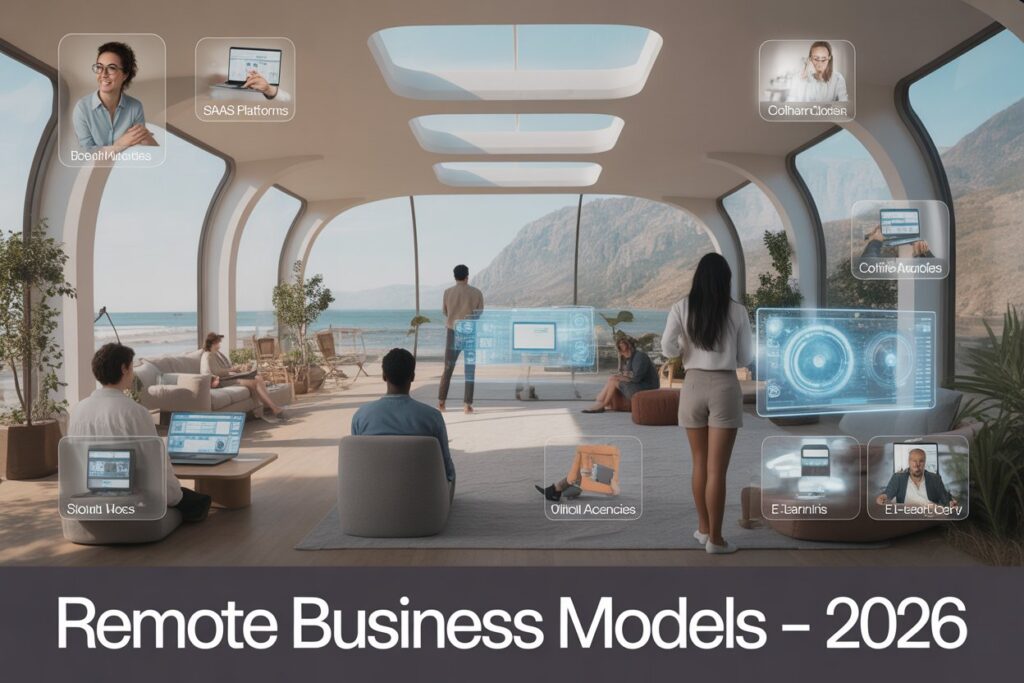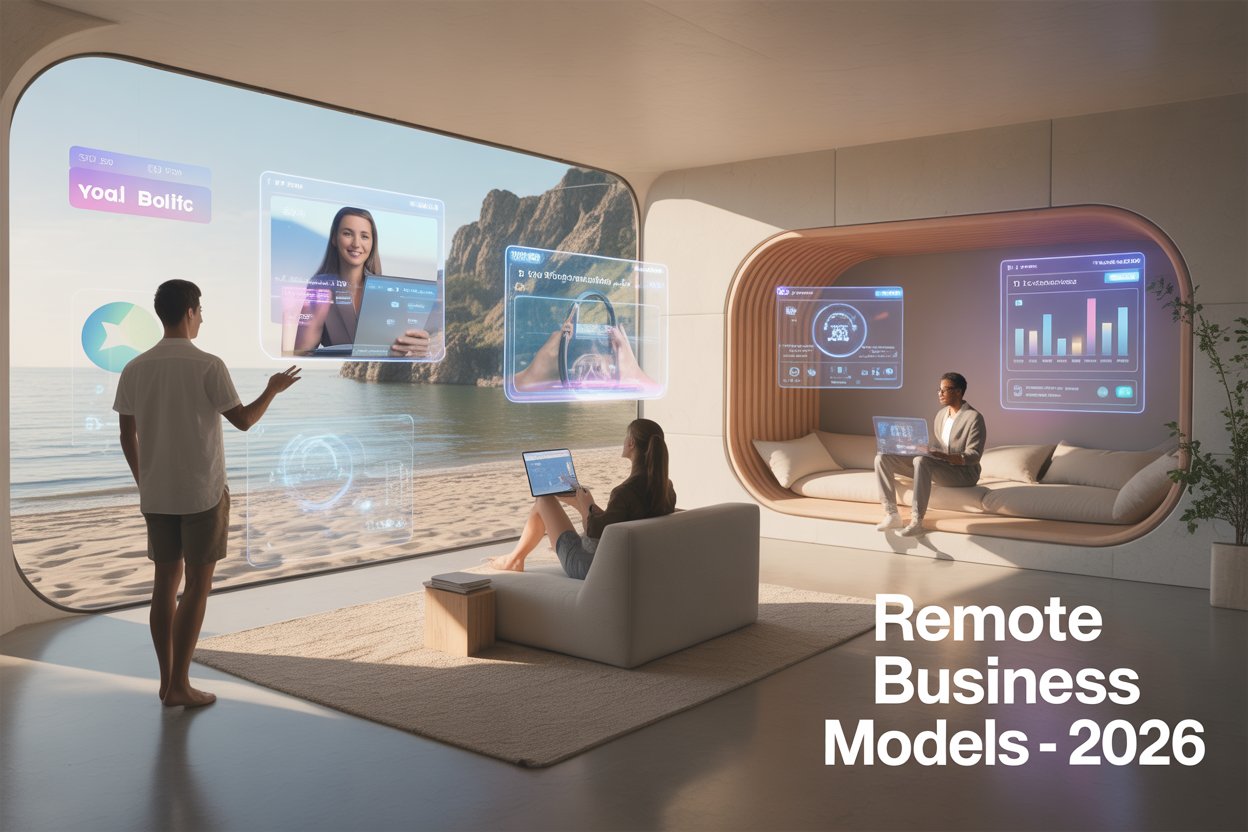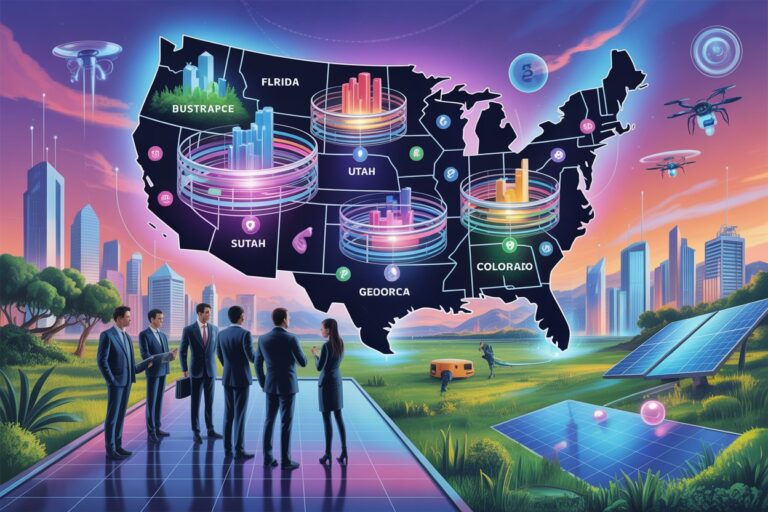Remote Business Models 2026
Introduction
As we approach 2026, remote business models have become a vital part of the global economy. With technology continuously evolving and the rise of digital-first mindsets, more entrepreneurs, freelancers, and corporations are shifting to remote-first or fully remote models.
This transition is not just a trend but a transformation that has created a new landscape of opportunities for businesses of all sizes.
This article explores various remote business models that are expected to thrive in 2026, suitable for aspiring entrepreneurs, startups, and even traditional businesses aiming to pivot.
The Rise of Remote Work: Background and Impact

From Necessity to Norm
The shift to remote work began as a necessity during the pandemic. By 2026, it has become a permanent solution for many industries, offering flexibility, efficiency, and access to a global talent pool.
Benefits for Entrepreneurs and Businesses
- Reduced operational costs
- Access to a wider workforce
- Increased productivity and employee satisfaction
- Scalability and agility
Alignment with Google and AdSense Policies
For new websites in the YMYL niche, it’s critical to present trustworthy, verified, and user-friendly content. Remote business models allow low-risk entrepreneurship when structured legally and ethically.
Types of Remote Business Models in 2026
1. Freelance and Contract-Based Services
Freelancers provide services like writing, graphic design, marketing, video editing, and programming. They operate independently or on platforms like Upwork and Fiverr.
2. Virtual Agencies
A virtual agency brings together remote freelancers under one digital roof. Examples include content marketing agencies, social media firms, and web development teams.
3. SaaS (Software as a Service)
SaaS companies develop cloud-based software products that users can access remotely. The business model relies on subscriptions and remote customer support.
4. Affiliate Marketing & Niche Blogging
By creating content that promotes other companies’ products, remote entrepreneurs can earn commissions. Popular niches include tech, finance, health, and digital tools.
5. Dropshipping
Entrepreneurs set up online stores without holding inventory. Products are shipped directly from suppliers to customers via platforms like Shopify and Oberlo.
6. eLearning Platforms
Remote educators and course creators offer video tutorials, eBooks, and quizzes via platforms like Teachable or Thinkific.
7. Remote Consultancy & Coaching
Professionals in finance, career development, legal, or marketing can provide one-on-one guidance via Zoom or Google Meet.
8. Subscription-Based Communities
Platforms like Patreon and Substack allow creators to build paying communities around exclusive content or coaching.
9. Remote Tech Support or IT Services
Tech professionals can provide remote troubleshooting, cybersecurity support, and network setup from anywhere in the world.
10. Digital Product Creation
Ebooks, templates, stock photos, UI kits, and more can be sold via Gumroad or personal eCommerce sites.
Technology Driving Remote Models in 2026
AI & Automation
AI handles repetitive tasks, improves customer service, and enhances marketing through personalized experiences.
5G and Cloud Infrastructure
High-speed internet and scalable cloud platforms like AWS and Google Cloud allow for seamless collaboration and data storage.
Project Management Tools
Software like Notion, Asana, Trello, and Monday.com streamline task assignment, goal tracking, and communication.
Legal and Ethical Considerations for New Remote Entrepreneurs
Business Licensing
Even remote businesses need proper registration, tax IDs, and compliance with U.S. state and federal laws.
Data Protection & Privacy
Ensure your business respects GDPR, CCPA, and other data regulations, especially when handling customer data remotely.
Accurate Representation
Avoid making false claims about earnings or business opportunities to stay in line with Google’s YMYL and AdSense policies.
How to Launch a Remote Business in 2026
Step 1: Choose a Profitable Niche
Focus on what aligns with your skills and the market demand. Conduct keyword research and competitor analysis.
Step 2: Build a Strong Online Presence
Set up a professional website, optimize it for SEO, and maintain active social media profiles.
Step 3: Utilize Automation Tools
Use scheduling apps, CRM software, and analytics dashboards to increase efficiency.
Step 4: Offer Real Value
Whether it’s a service, course, or product, ensure it solves a real problem.
Step 5: Stay Updated
Subscribe to industry newsletters, attend webinars, and adapt quickly to new tools and trends.
Future Outlook: What’s Next for Remote Businesses?
Integration of Virtual Reality (VR) Workspaces
Companies may shift to immersive VR environments to simulate in-person collaboration.
AI-Driven Personal Assistants
Expect smart assistants to handle scheduling, email, and task reminders with more human-like interaction.
More Decentralized Teams
Blockchain-based management tools and global hiring platforms will support autonomous and borderless teams.
Tips for Scaling Remote Business Operations
Standardize Processes
Create SOPs (Standard Operating Procedures) to ensure consistency in tasks.
Hire Globally, Manage Locally
Use platforms like Deel, Remote.com, and OysterHR to manage international contractors.
Invest in Team Culture
Even if your team is remote, regular team-building sessions and shared goals are essential.
Conclusion
Remote business models in 2026 offer a viable, scalable, and low-overhead path to entrepreneurship.
With the right tools, legal structure, and value proposition, you can build a profitable remote business that aligns with both user trust and Google’s policies. As you grow, prioritize transparency, reliability, and user satisfaction.






